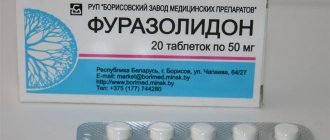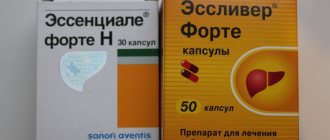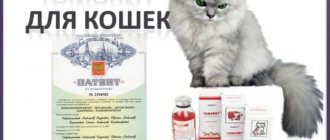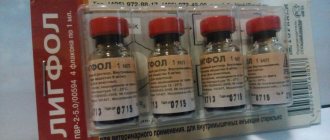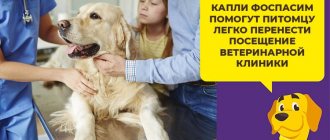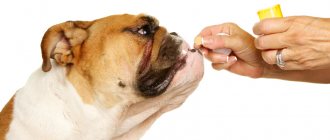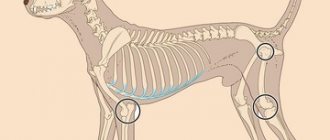In the dog’s body, just like in the human body, inflammatory processes can occur, ulcers and foci of inflammation can form. One of the most severe and painful forms of inflammation for an animal is an abscess. It can appear on any part of the dog's body and grow greatly if not treated properly.
In this article we will look at the main causes of an abscess, its types and methods of the most effective treatment, which will help your animal get rid of pain and discomfort in a matter of days.
Abscess in a dog
Purulent wounds
All wounds except operating wounds are infected. That is, pathogenic flora penetrates into the damaged area. For example, bite wounds are almost always contaminated with pathogenic agents. Under favorable conditions, microorganisms actively multiply quite quickly, provoking acute inflammation.
As a rule, the appearance of purulent wounds in dogs is promoted by: Klebsiella, Pseudomonas aeruginosa, Escherichia coli, streptostaphylococci. During their life, bacteria produce endotoxins, which not only destroy tissue and provoke inflammatory processes in the deep structures of the dermis, but also poison the entire body of the pet.
Wounds can be superficial, deep, or penetrating. After injury, the so-called wound process is activated, which occurs in three phases:
- inflammation;
- regeneration;
- scar formation, epithelization.
Dogs lick small abrasions and small wounds on their own. The acceleration of regeneration is facilitated by bactericidal enzymes contained in the saliva of pets. Purulent wounds require longer complex treatment and a competent approach.
Important! You can provide first aid to your dog at home. Further therapy should be prescribed by a veterinarian. In order not to aggravate the situation, you should not self-medicate. Antibacterial drugs should be selected by the attending veterinarian based on the results of diagnostics and microbiological tests.
In traditional veterinary medicine, to accelerate the healing of purulent, infected wounds in dogs, symptomatic treatment and antibiotic therapy are prescribed. Antibacterial ointments and gels are used for local treatment. creams, liniments. Additionally, pharmacological drugs in tablets and complex, broad-spectrum antibiotics may be prescribed.
What antibiotics are used to treat dogs?
Very often, owners are interested in whether dogs can be given antibiotics intended for humans. But in fact, there are no special dog antibiotics. What is sold in veterinary pharmacies are the same products, but with a lower dosage.
The following groups of antibiotic drugs can be used in the therapy of dogs:
- Antibiotics belonging to the penicillin series, including those of semi-synthetic origin - Ampicillin, Flemoxin Solutab, Amoxicillin, Amoxiclav, etc.
- Cephalosporins - there are four generations of drugs and the more modern the generation, the more effective the drug against gram-negative flora. Pseudomonas aeruginosa and Escherichia coli are particularly resistant to antibiotics.
- Macrolides - Erythromycin, Clarithromycin, Macropen, Azithromycin, Spiramycin, etc. In most cases, they are used for diseases of the respiratory tract and pneumonia.
- Carbapenems - Meropenem, Meronem, Doripenem, Imipinem, etc. They are highly effective against staphylococci.
- Tetracyclines – natural: Tetracycline, Terramycin, Biomycin, and semi-synthetic: Metacycline, Doxycycline, Clinomycin. Used for tick-borne borreliosis and cystitis in dogs.
- Aminoglycosides - Tobramycin, Gentamicin, Kanamycin, Amikacin. They are effective against gram-negative pathogens and are highly toxic, so they are used exclusively for indications.
- Levomycetins - used for intestinal disorders.
- Fluoroquinolones – Ofloxacin, Pefloxacin, Ciprofloxacin, Levoflox, Levofloxacin. Used to treat cystitis, gastrointestinal infections, severe forms of pneumonia.
- Fungicidal antibiotics - Nystatin, Levorin, Amphoterecin B, are used only against the elimination of pathogenic fungi.
Among antibiotics, there is another group of drugs - anti-tuberculosis drugs (Streptomycin, Isoniazid, Rifampicin, Ftivazid). This group is intended for the treatment of people, but is extremely dangerous for animals. After taking them, the dog may not survive.
Antibiotics used for pets have different effects on infectious agents - bacteriostatic, in which they slow down and stop the growth of bacteria, or bactericidal, killing them.
In severe infectious diseases, especially those caused by gram-negative pathogens, it is recommended to begin antibiotic therapy with drugs that have a bacteriostatic effect. This will help avoid infectious-toxic shock, which is caused by a large intake of toxic substances released by dead bacteria into the blood.
Infectious agents quickly develop resistance to these types of drugs, so you should not abuse them.
If it is not possible to immediately identify the cause of the infection, then antibiotic drugs are prescribed, which have a fairly wide range of applications, since they are effective against various pathogenic microorganisms.
There are also general antibiotics; they can penetrate the tissues of various organs and systems, or agents that act only in the intestines.
Preventive actions
By following a number of simple rules, you can protect your pet from the disease and prevent the formation of purulent lumps. These include:
- maintaining careful hygiene;
- regular inspections of the animal for damage;
- treatment of even minor wounds;
- ensuring proper care of the animal;
- regular veterinary examinations.
Abscesses cannot be ignored to prevent complications. An abscess can form in a short time and grows rapidly, affecting and destroying healthy tissue, and there is also an intensive proliferation of microbes that can infect the entire body of the animal.
First aid
Faced with a similar situation before the veterinarian arrives or travels with the pet to the veterinary clinic, it is very important to prevent infection and prevent the development of the inflammatory process. If the damage is quite extensive and dirty, first of all, wash the affected area with plenty of warm water and laundry soap.
At the next stage, use sterile tweezers to try to remove foreign particles that have entered the wound. Carefully trim the fur around the affected area with sterile scissors. Treat the skin around the purulent wound with brilliant green, alcohol tincture of iodine, using disposable gauze and cotton pads. A short novocaine-antibiotic block is administered. Partial excision of dead tissue may be necessary, followed by drainage of the wound. Conducted in a veterinary hospital.
To wash wounds, you can use any aseptic means: a weakly concentrated 3% solution of potassium permanganate, furatsilin, chlorhexidine, propolis tincture, calendula, plantain decoction, and other medicinal plants.
Important! If the wound has been sutured, the seams are treated daily with disinfectant solutions for five to seven days.
Wound healing preparations (solcoseryl, actovigin, vinylin, Levomikol) are applied to a clean wound. In severe advanced cases, to prevent the development of infection or if the wound is already infected, local bactericidal, anti-inflammatory drugs (ointments, creams, pharmaceutical mash), and complex antibacterial agents must be used. After treatment, the wound is covered with a sterile bactericidal plaster and a bandage is applied.
Antibiotics for animals with purulent wounds
A course of antibiotic therapy for purulent open wounds should be prescribed by a veterinarian. In complex therapy for four-fingered patients, antibiotics of the penicillin, cephalosporin, tetracycline series, ampicillins, and macrolides are prescribed orally to prevent infection. Therapeutic therapy for purulent wounds should also be selected taking into account the phases of the wound process.
Antibiotics are selected based on the results of microbiological tests and bacteriological studies aimed at determining the sensitivity of pathogenic flora to certain drug substances. Additionally, in the initial stages of treatment of purulent wounds in dogs, pharmacological anesthetics are used.
For local treatment, a good wound healing effect is noted after the use of antibacterial ointments, gels, and creams. Dogs are prescribed:
- Levomikol.
- Liniment Syntomycin 5%.
- Tetracycline 3% ointment.
- Ranosan.
- Betadine.
- Safroderm-gel.
- Sangel.
- Gentamicin ointment.
- Septogel.
The above listed pharmacological agents have a pronounced bactericidal effect, relieve swelling, prevent degenerative-destructive processes in tissues, and accelerate regeneration processes. Used for the treatment of pustular lesions of soft tissues, furunculosis, purulent abscesses in animals, in the presence of open wounds infected with pyogenic flora.
Popular drugs
The pharmaceutical veterinary market is rich in antibacterial drugs, which differ in their principle of action, composition, and release form. It is important for the dog owner to understand that self-prescribing this or that medication is fraught with serious complications. However, it is still worth familiarizing yourself with the list of popular medications.
"Tsiprovet"
This is a relatively safe systemic agent. Available in the form of tablets and drops. Drops are widely used for ophthalmological diseases characterized by infectious origin: blepharitis, conjunctivitis, uveitis, corneal ulcer. "Tsiprovet" is also indicated in the case of purulent processes in the eyes.
The tablets are effective for bronchitis, pneumonia and other viral diseases. In addition, the medication is active in cases of inflammation of the genitourinary system and infectious diseases of the gastrointestinal tract. The drug is also prescribed for lesions of soft tissues, bones, and joints.
"Tsiprovet" is contraindicated for pregnant and lactating bitches, puppies, and animals with disorders of the central nervous system.
"Amoxicillin"
A complex action drug that effectively destroys pathogenic bacteria and viruses. The product is produced in the format of injections, suspensions and tablets. The components of the medication are active in the case of diseases of the genitourinary system and gastrointestinal tract.
Similar article: Instructions and tips for using Cantaren for dogs
Injection dose: 1 ml per 10 kg of animal weight. The dose of tablets is calculated similarly. Amoxicillin is contraindicated in dogs that are intolerant to certain components of the drug.
Antibiotics in tablets
In case of severe infection, extensive lesions of soft tissues, antibiotics are prescribed to dogs in the form of tablets, injection solutions for IV, IM administration. The tissue surrounding the wound is often injected with an antibacterial drug. The duration of treatment depends on the clinical manifestations, nature, and condition of the purulent wound.
Important! Antibiotics for wounds, if there are no other indications, are used only for purulent processes.
When treating purulent wounds in dogs, the following is used:
- Cephalexin.
- Cefuroxime.
- Amoxiclav.
- Kanamycin.
- Oxacillin.
- Betamox.
- Doxycyline.
- Amuril.
- Tetracycline.
- Erythromycin.
- Enroxil.
- Neomycin.
- Metacycline.
- Cefapime.
- Gentamicin.
Penicillin antibiotics (amoxiclav, penicillin) have a negative effect on almost all types of pyogenic flora. Cephalosporins kill gram-negative bacterial flora and act on E. coli.
Macrolides and carbapenems (imipinem, meronem) have a good effect on streptostaphylococci. Kanamycins prevent the development of gram-positive and gram-negative pathogenic pyogenic microflora. Used for the treatment of purulent-septic diseases, including extensive purulent wounds in dogs. Kanamycin is often prescribed to animals during the postoperative period to prevent infection of postoperative wounds.
Types of antibiotics for dogs
There are no special antibacterial agents developed exclusively for animals. The range of veterinary pharmacies is represented by drugs similar to humans, but in a lower dose. As a rule, doctors use medications with complex effects.
Multifunctional antibiotics successfully fight many types of gram-positive and gram-negative bacteria. Their use is especially justified when the disease cannot be diagnosed or there is a need to stop dangerous symptoms as soon as possible.
The success of therapy depends on the sensitivity of bacteria to the drug
In addition to a wide range of effects, there are groups of “spot” antibiotics that affect only certain pathogens.
Table 1. Groups of antibiotics
| Group | Names of medications | Application |
| Penicillin antibiotics |
| Bacterial diseases of infectious etiology |
| Cephalosporins |
| Skin infections, pneumonia, urethral diseases. Affects gram-negative bacteria |
| Macrolides |
| Lung diseases and oral infections |
| Carbapenems |
| Infectious pathologies of the pelvic organs. Effective in the treatment of staphylococci |
| Tetracyclines |
| Borreliosis and cystitis |
| Aminoglycosides |
| Tularemia, infectious intestinal diseases |
| Levomycetins |
| Intestinal disorders, pneumonia |
| Fluoroquinolones |
| Cystitis, pneumonia, gastrointestinal infections |
| Fungicides |
| Pathogenic intestinal microflora |
Anti-tuberculosis drugs - "Ftivazid" and others - are dangerous for the lives of four-legged pets
Antibiotics are produced in the following form:
- gels;
- pills;
- ointments;
- drops;
- solutions.
The most effective antibiotics
Broad-spectrum antibiotics are considered the most popular. Based on the recommendations of veterinarians, the following drugs can be included in this group:
- "Amoxicillin";
- "Gentamicin";
- "Betamox";
- "Triprim";
- "Norfloxacin";
- "Terramycin";
- "Baytril";
- "Sinulox";
- "Ceftriaxone";
- "Engemicin".
Doctors especially often use Amoxicillin in their practice.
There is an opinion among dog lovers that the dog’s body responds better to antibiotics than the human body.
Table 2. Recommended drugs for the treatment of certain pathologies
| Disease | Names of medications |
| Pneumonia | Penicillins:
|
| Otitis |
|
| Cystitis | "Kobaktan" |
| Purulent conjunctivitis | "Tsiprovet" |
Amoxicillin for dogs
Amoxicillin is an antibiotic with complex effects. Destroys both gram-negative and gram-positive bacteria. Among the negative side effects from using the drug are allergic reactions and conjunctivitis, which are quite rare.
Amoxicillin is well tolerated by four-legged pets
Indications for use:
- leptospirosis;
- cystitis;
- bronchitis;
- hepatitis;
- stomach diseases;
- endometritis.
The product is produced in the form of tablets and injection solutions.
Dosage
The solution is administered only intramuscularly. Calculation principle: 1 ml per 10 kg of pet’s body weight. Accordingly, per 1 kg of weight there are 15 mg of active substance.
The solution is administered intramuscularly only
Contraindications
This medication is not designed for intravenous injection. The use of the product is not recommended in the following situations:
- combination with chemotherapy drugs;
- combination with other agents in one syringe
Amoxicillin is also not used if there is sensitivity to elements of the penicillin group.
How to treat a dog's wound yourself
If an injury is detected in a furry pet, the owner must provide emergency assistance. Veterinary experts recommend performing the following independent manipulations:
- Using blunt-tipped nail scissors, trim the hair around the wound. The procedure is performed on both short-haired and long-haired breeds of animals.
- Using a clean napkin, bandage or gauze, remove foreign objects that have entered the wound (dirt, sawdust, pieces of metal, brick, hair, etc.).
- In case of heavy contamination, the surrounding skin should be thoroughly washed with a soap solution that helps quickly soften dried dirt and blood.
- If there is bleeding from the wound, measures must be taken to eliminate it. For this purpose, 3% hydrogen peroxide is used. The product interacts with the blood, forming air bubbles. This can frighten the animal, so the dog should be encouraged, petted or distracted before manipulation.
- After the bleeding has stopped, it is necessary to begin treating the wound itself. For this purpose, veterinarians recommend using hydrogen peroxide, a solution of Chlorhexidine, Furacilin, Miramistin.
- To disinfect the wound canal with antiseptic solutions, it is convenient to use gauze wipes and a rolled bandage. In the field, you can use a clean scarf or piece of cotton fabric.
- A small amount of anti-inflammatory ointment must be injected into the wound using a syringe without a needle. For this purpose, chloramphenicol or streptomycin ointment, Levomekol, is suitable.
- The wound can be sprinkled with streptocide powder.
- After treatment, the wound surface must be covered with gauze. This will help reduce the risk of infection and promote longer retention of drugs in the pathological focus.
- The dog should not be allowed to lick or injure the wound with its limbs. For this purpose, a bandage is applied or a special collar is put on the animal’s neck, which prevents the pet from harming itself.
Self-treatment of a wound does not in any way exclude a visit to a specialized institution with your furry pet.
Abscesses on a dog’s body: causes, localization
Doctors call bite wounds another common cause of abscesses. If your pet is bitten while playing with another dog, and you do not treat the area, an abscess may appear. With serious open wounds, the risk of infection is much higher: the area is treated several times a day, a bandage is applied, and internal therapy (antibiotics) is used.
An abscess on a dog's neck appears due to a tight or hard collar. If heavy leather products, weighted with spikes or chains, are suitable for large dogs, then narrow soft models are selected for Yorkies. Also, miniature breeds should not have a harness attached to a neck leash: they have a fragile neck. It is better to use a leash that fits around the body (like a cat's leash).
If your dog has an abscess on his face, you should be wary. It is located in close proximity to the brain, jaw, and large vessels. It happens that a pet scratches a lip or cheek, and by licking the wound, it causes an infection.
Such ulcers interfere with eating; pus gets on the mucous membranes, which can spread. Therefore, an abscess on the face requires close attention and treatment.
A common place for boils. Firstly, some breeds have it docked. If the procedure is performed under unsterile conditions, there is a possibility of an abscess. Secondly, a dog develops an abscess on its tail due to active play or accidental injury. In any case, it needs to be examined and removed by yourself or by a veterinarian.
Fighting coughs of allergic origin
Do not forget that your dog may cough due to allergies. In such cases, the following remedies are prescribed:
- Diphenhydramine. They give one tablet per pet. It must be remembered that this medicine can make the dog very lethargic and apathetic.
- Zyrtec. The standard dosage is 5-10 mg of active ingredient per dog per day.
- Regular Suprastin . Give ½ or a whole tablet up to two times a day.
- Cetirizine. Dose – from 2 to 4 mg/kg body weight once a day. The duration of administration to a dog is three days.
source
Treatment of inflamed formation
Treatment of a purulent wound requires professional intervention, since infection increases the risk of developing sepsis in a sick animal.
You should definitely contact a veterinarian if your dog refuses to eat, is lethargic, or has an elevated body temperature.
Therapeutic measures include surgical cleansing of the wound from purulent exudate, the use of antiseptics, antibacterial and restorative drugs, and installation of drainage. Sutures are not used for symptoms of purulent inflammation.
Cleansing the wound
An important condition for successful treatment of a wound with a purulent process is its cleansing. For this purpose, the animal undergoes surgical manipulation in a veterinary clinic. Under local anesthesia, the wound channel is opened, necrotic tissue is excised, and purulent exudate is removed.
During the procedure, the purulent pockets are opened and cleansed. Manipulation, as a rule, is accompanied by infiltration anesthesia with a solution of novocaine with an antibiotic.
After surgical cleaning of the wound, the veterinarian treats the tissue with antiseptic solutions. For this purpose, use a 3% solution of potassium permanganate and a 0.1% solution of Rivanol, similar to hydrogen peroxide. An effective remedy for the antiseptic treatment of purulent wounds is a 2% solution of Chloramine and a 0.5% solution of Chlorhexidine.
Hypertonic antiseptics are often used in veterinary practice to remove purulent contents.
After cleansing and treatment with disinfectants, antimicrobial ointments are used. Levomikol, Vishnevsky ointment, Lincomycin ointment, Tyrosur, Baktroban, Olive liquid have a good therapeutic effect.
To learn how to treat a purulent wound for a dog, watch this video:
Drainage
In veterinary practice, drainage is used to treat deep purulent wounds.
After surgical cleansing of the pathological focus from necrotic tissue and purulent exudate, special tubes are inserted into the wound cavity (passive drainage). The devices are made of rubber or vinyl chloride. Thanks to drainage, pus is removed from the wound. To prevent the tubes from falling out of the wound cavity, they are securely fixed, sewn with rare stitches to the skin of the animal.
Drainage in the wound
The catheter is left in the wound until complete healing. This period can be 5 - 10 days, during which the owner should treat the drained area with antiseptic solutions of Furacilin, potassium permanganate or Chlorhexidine.
Often, in the treatment of a purulent process, veterinary specialists resort to active drainage with the help of turundas. A narrow gauze swab (a bandage rolled into a napkin) is soaked in antimicrobial ointment and inserted into the wound cavity. Due to its hygroscopic properties, such a simple device absorbs purulent exudate. Turundas are placed for 1 - 2 days, after which passive drainage is used using special catheters.
Antibiotic therapy: pros and cons
- ease of administration, low dosages with a high therapeutic effect, significant reduction in the course of the disease. There are drugs used in short courses or even as a single injection due to their prolonged action;
- noticeably faster recovery of the pet;
- the presence of broad-spectrum drugs (this property is useful when the decision on treatment needs to be made immediately, and there is no time to determine sensitivity to a particular highly specific antibiotic);
- suppression of the development of secondary infections, which significantly reduces the risk of complications from illness;
- a noticeable therapeutic effect, even with a very high concentration of bacteria in the body.
Disadvantages and side effects:
- if antibiotics are incorrectly selected and taken incorrectly, the body’s fight against infections is significantly weakened;
- side effects if the dosage is calculated incorrectly (it’s bad both when the dose is exceeded and when it’s not enough);
- long courses of antimicrobial therapy reduce its effect as microorganisms become accustomed to the drug;
- in rare cases, disruption of intestinal microflora.
With the correct selection of an antibacterial drug and accurate dose calculation, all side effects are minimized, and the shortcomings are compensated for by a positive therapeutic effect!
Diagnostics
Any competent veterinarian, before starting treatment for an abscess, will conduct a differential diagnosis of this disease. Its goal is to exclude hernia, hematoma (seal from a bruise) and tumor. To do this, the doctor will conduct a series of studies:
- collecting anamnesis (symptoms and order of symptoms);
- palpation of the source of inflammation;
- assessment of the temperature of inflammatory and nearby tissues;
- biopsy of inflammation (collection of purulent contents for analysis - if present);
- MRI, ultrasound - for internal abscesses.
Only a specialist can open and disinfect an abscess.
Useful video
For information on how and what to treat a wound, watch this video:
A wound in a dog is a common occurrence, because they are by nature very active animals. They are always interested in everything, they often get into dog fights. Even if your dog is well-mannered and calm, during a walk he can become a victim of homeless dogs, who, unfortunately, still run in packs along our streets.
Lovers of these animals should always be prepared for such a possibility. If something happens, do not panic, but be able to provide first aid, know how to proceed further, and be patient. After all, therapy for dog wounds always requires considerable patience from both the pet and its owner.
Causes and routes of infection
The cause of the disease in the nursery is a decrease in immunity as a result of the listed unfavorable factors:
- Unsatisfactory sanitary condition of walking and living areas.
- Unbalanced feeding of natural food or ready-made economy class products.
- Worminess.
- Failure to comply with the vaccination schedule.
The cause of illness in a pet is contact with a sick dog. You can become infected while walking, visiting an exhibition, a pet store, or a veterinary hospital. Pathogens are transmitted through droplets produced by coughing. In dogs with a strained immune system, the disease is asymptomatic. Animals with weakened immune systems—unvaccinated puppies, as well as older pets—are seriously ill.
The consequences of the disease are dangerous. You, of course, have heard that kennel cough does not need to be treated. The dog will still recover on its own. In most cases this is what happens. However, the severity of the disease depends on the characteristics of the animal. It is not the disease itself that is dangerous, but its consequences. If measures are not taken, the animal develops pneumonia, which requires long-term treatment, and in severe situations ends in the death of the dog.
Watch the video:
What is a wound on a dog?
In order to provide emergency assistance and to develop subsequent actions for treating a pet, each owner must be able to assess the nature of the wound, its size, the depth of the lesion, the presence of bleeding and its intensity. The main types of injuries are:
Abrasions (scratches), splinters - damaging the top layer of skin, provoking a slight inflammatory process on it and barely noticeable bleeding, the formation of bruises. This can happen for any reason: from the owner’s inept handling of the leash to the dog touching various objects and plants, active scratching, etc. Such injuries are simple and do not require going to a veterinary clinic, but can be treated at home;
Lacerations, which also include cuts, are the result of deeper damage to the animal’s skin. The reasons for this can be different, but the cut itself can be smooth, clean and shallow or deep, when the edges do not have a clear outline (torn) and all layers of the skin are affected, right down to the muscle tissue;
Puncture wounds and bites are dangerous due to the possibility of rapid bacterial infection. These wounds, especially small ones, are difficult to immediately identify, and if therapeutic and disinfecting measures are not taken in a timely manner, they quickly become inflamed and cause suppuration. Such purulent wounds in dogs require immediate treatment;
Injuries are the most complex and life-threatening injuries. Occurs as a result of beatings, accidents, accidents.
When to see a veterinarian
Home treatment for all types of wounds is indicated only when the animal has received a superficial injury that does not pose a threat to its life. In other cases, it is necessary to show your pet to a veterinarian. This should not be neglected if:
- this is a bite - the animal that caused such an injury may be sick, in particular with rabies, which is dangerous not only for the life of the pet itself, but also for members of the entire family;
- The dog’s wounds do not heal - only a specialist can determine the reason for this; the animal is severely injured - any delay in this case may cost its life;
- severe bleeding, especially that cannot be restored;
- an extensive wound on the head, a fracture, or other cases requiring special treatment methods or the use of potent drugs.
What antibiotics should dogs be treated with?
Groups of antibacterial agents are the same in structure and purpose in both human and veterinary medicine. The differences are only in dosages and production method.
The following groups of antibiotics are used to treat dogs:
- penicillins, including semi-synthetic ones (Ampicillin, Amoxicillin, Amoxiclav, etc.);
- cephalosporins, which are divided into four generations and are effective against gram-negative bacteria;
- macrolides, they are usually used for diseases of the respiratory system (Erythromycin, Azithromycin, Macropen, etc.);
- carbapenems - most often used against staphylococci (Meropenem, Meronem, Imipinem, etc.);
- tetracyclines - indicated for cystitis and borreliosis in dogs (Tetracycline, Terramycin, Biomycin, Doxycycline, etc.);
- aminoglycosides - effective against gram-negative flora, but have high toxicity, therefore they are used strictly according to indications (Gentamicin, Kanamycin, etc.);
- chloramphenicol – prescribed for diseases of the gastrointestinal tract;
- fluoroquinolones - used in the treatment of cystitis, gastrointestinal infections, severe pneumonia (Ofloxacin, Ciprofloxacin, etc.);
- fungicides - needed to combat pathogenic fungi (Nystatin, Levorin, etc.).
There is also a group of anti-tuberculosis drugs that are great for people, but can be fatal for dogs.
Antibiotics for pets, as for people, can have a bacteriostatic or bactericidal effect. Bacteriostatic drugs stop the proliferation of bacteria, and bactericidal drugs kill pathogens.
If for some reason it is not possible to immediately identify the cause of the infection, the dog is prescribed broad-spectrum antibiotics. Such drugs fight against several pathogens at once.
What is an abscess like?
People often call abscesses “abscesses,” but this is a fairly general concept, because there are different types of abscesses. An abscess in a dog can occur under the skin, in which case it will be called superficial, or located inside the body, such abscesses are called deep. Their size also varies. They can be small or the size of a chicken egg. A characteristic feature of this process is a clear boundary between inflamed and healthy tissue.
An abscess may result from necrosis caused by microorganisms (aseptic abscess). Sometimes it develops as a result of a heart attack or tissue necrosis resulting from intoxication when poison gets under the skin, then it is called aseptic.
As a result of incorrectly administered injections or vaccinations, swelling appears on the skin; they look like red, elastic tubercles filled with thick pus. Such an abscess is called benign. Red bumps with liquid pus contained in them are a manifestation of a malignant abscess. The inflamed area may have different temperatures.
“ Hot ”, when the temperature of the swelling itself is higher than the temperature of the whole body, and the place itself is painful. The process develops rapidly, the swelling can increase very quickly, and often the abscess opens on its own.
" Cold " when the abscess develops very slowly. It is difficult to identify, since there are no clear signs. The help of a veterinarian is needed, since the abscess itself cannot open. Most often this happens in old animals whose immunity is weakened.
Abscesses and their causes
The area of spread rapidly increases due to the disintegration of abscess tissue and the formation of new microorganisms. The latter enter the blood, thus the lesion becomes larger and larger, very quickly its area increases significantly.
Often, superficial abscesses appear as a result of a violation of the integrity of the skin, wounds and injuries. The dog was scratched, someone bit him, he hit himself, or he was given an injection. The place where the wound appeared turns out to be infected, dirt and infection get there, which means an abscess develops. Most often, dogs have ulcers on their paws. Factors contributing to abscesses:
- lack of proper care and hygiene rules, when the animal’s fur and paws are constantly dirty;
- the aggressive nature of the dog, he conflicts with other dogs, loves to fight;
- accidents, human cruelty;
- females in a “gust of passion” can bite the male who has chosen them, or males arrange fights for the right to choose a female;
- The veterinarian did not follow the recommendations when preparing for the injection and after it.
The causes of deep abscesses are old, poorly treated wounds, the presence of wood chips, debris and dirt in the tissues. Pathological formations with parasites entering the internal organs can be dangerous for a dog’s life. Often they end up on the liver, kidneys or lungs, the parasite dies, but the disease remains and progresses.
There are many “secluded corners” in the animal’s body where there are favorable conditions for the development of pathogenic microflora. And if leukocytes are not able to cope with microorganisms, then a dangerous and insidious abscess occurs. The body, as it were, protects the animal by covering the abscess with walls, so identifying it in a timely manner is not easy even for an attentive owner. An abscess can appear anywhere - on the jaw, on the ears or on the paws.
How to give a dog an antibiotic
Broad-spectrum antibiotics can be given to dogs and other pets only on the recommendation of the treating veterinarian. If the drug is prescribed in tablets, the pill can be crushed into powder, mixed with a small amount of minced meat, porridge, cookies, a piece of raw meat, or canned food.
Important! Not all antibiotics can be given with food, so read the instructions carefully.
Some antibiotics can be dissolved in water and milk. In this case, the medicine is injected into the dog's mouth using a special introducer syringe, which can be purchased at a pet store or veterinary pharmacy, or using a regular disposable syringe without a needle.
You can forcefully give your dog medicine by placing a tablet on the root of the tongue. Secure the pet, open the animal's mouth wide. Wait until the dog swallows the tablet. Reward your pet with his favorite treat.
Intravenous, intramuscular, subcutaneous injections of antibacterial drugs are best given to your dog by a veterinarian.
Before using an antibacterial drug, carefully read the instructions and adhere to the dosage prescribed by your doctor. After taking antibacterial drugs, carefully monitor the behavior and health of your beloved dog.
Drugs that help fight infections of bacterial origin occupy a significant niche in the medical drug market. Experts actively use them in the treatment and prevention of human ailments and diseases of domestic animals. Veterinarians often use antibiotics for dogs in their practice. Which drugs are the most effective and how to correctly administer the medication to your pet, read on.
If the pet’s body is unable to fight off the infection on its own, the doctor prescribes antibiotics for dogs.
First aid
When a dog is injured, certain measures are required on the part of its owner:
- First, treat the wound with a solution of hydrogen peroxide, potassium permanganate, furatsilin or chlorhexidine. If you don’t have these products in your home medicine cabinet, you can use clean running water.
- Shave or trim the hair around the wound.
- Lubricate the area around the wound well with iodine or Monclavit-1 (a modern disinfectant preparation based on iodine).
- Try to stop the bleeding using a homeostatic bandage and tight bandaging.
After these actions, preferably without the slightest delay, even with a seemingly trivial wound, you need to show the animal to a veterinarian. After all, poor-quality treatment or incorrect actions by the owner of a four-legged pet can lead to various complications. And with bleeding, any delay could even cost his life.
Prevention
According to statistics, 50% of all dogs have had an abscess at least once in their lives. But we’ll tell you further what you need to do to protect your pet from this unpleasant disease.
- Check your pets' paws carefully after every walk. Dirty weather and any wound can cause inflammation.
It is recommended to carefully examine the paw pads after walks - this is the most vulnerable place for minor abrasions.
- Provide your pet with adequate nutrition. Good immunity is a guarantee of good self-defense of the body and immunity to pathogenic flora.
- Periodically (preferably 2 times a year - in spring and autumn) give dogs multivitamins in full courses.
Vitamin deficiency occurs not only in humans. Dogs also need “helpers” in maintaining health.
- Treat any cuts or wounds with hydrogen peroxide or chlorhexidine.
- Bathe your pet more often.
- Get your vaccinations up to date.
By following all these simple rules, you can save your pet and save him from severe suffering and pain, which are especially painful with an abscess.
How to treat wounds in animals
The main health hazard is lacerations in dogs. Typically, such a lesion does not heal quickly and often has undesirable consequences. Treatment of such a pathology, as a rule, requires surgical measures, because without this, pus and tissue particles that are semi-decomposed quickly accumulate in the wound, and a purulent wound in dogs is formed.
It is generally accepted that with this type of injury one should not worry only when it is minor (no more than 2 cm long, 1 cm deep). More serious cases always require immediate medical attention. It is especially needed when the pet’s wound begins to fester. At home, the animal should treat the affected area with hydrogen peroxide, pre-cut the hair, remove pus and dirt. And then the action is up to the specialists.
A drainage system will be installed in the animal clinic to help remove purulent discharge, which is not removed until the wound is completely cleaned and the inflammatory process is stopped. An antibiotic is always used in the form of injections for dogs for purulent wounds. This can be Biomycin, Terramycin, Gramicidin, etc. At the same time, wipes soaked in a solution that promotes the removal of exudate are applied to the wounded area. If the wound is serious enough, it is stitched up, but treatment is also prescribed. As a rule, antibiotics with a wide spectrum of effects are used, and in high doses.
It happens that hormonal drugs are also prescribed, although when treating complex lesions, when the treatment period lasts 2-3 weeks, such a prescription is not recommended. But vitamin complexes will come in handy here. After all, with their help you can improve metabolism, accelerate the production of leukocytes, and strengthen the animal’s body’s defenses. Often, tampons with Vishnevsky balm are applied to such wounds.
How to give an antibiotic to a dog?
It is not recommended to select the drug on your own. In addition to the fact that the medication may not help in treating the disease, its use is fraught with complications.
Antibacterial drugs can only be used as prescribed by a veterinarian
- Before choosing a product, it is necessary to give the dog a sensitivity test and conduct a laboratory test to determine its susceptibility to the active substances.
- If your pet has a viral disease, antibiotics are used only in case of complications.
- It is prohibited to deviate from the dosage specified in the instructions. This is fraught with intoxication of the body.
- The antibiotic must be administered at the same time every day. This is due to the fact that the level of medication in the blood must be constantly maintained.
- If signs of improvement appear, you should not stop the course of treatment. It is necessary to strictly adhere to the terms of therapy specified by the doctor.
- If an antibiotic is prescribed in the form of tablets, it is forbidden to forcibly squeeze the pet’s jaw. This may cause injury.
- If you have difficulty taking the tablets, the drug should be crushed and mixed with minced meat, canned food or porridge. You must first read the instructions, since not all products can be combined with food.
The tablet should be placed on the root of the tongue and the dog should be allowed to swallow it.
An overdose of the drug is accompanied by diarrhea and vomiting. Sometimes deafness is possible.
Injections cannot be given intravenously: only subcutaneously or intramuscularly
Rules for choosing a syringe
To reduce pain when injecting medication, you need to choose the needle size wisely.
Table 3. Rules for selecting a syringe
| Dimensions of the dog | Syringe characteristics |
| Small | Insulin:
|
Not suitable for administering large doses of medication. If your pet's skin is thick, the sharp end of the needle becomes bent. As a result, you have to put in extra effort during the injection.
An alternative is a tuberculin syringe:
- needle length - from 13 to 25 mm;
- diameter - from 0.3 to 0.5 mm;
- capacity - 0.1 ml.
Allows painless injection into the subcutaneous layer
Medium or large Since the dosage is calculated based on the weight of the animal, a 2 or 5 ml syringe should be used. In order not to unnecessarily injure the skin tissue, you should attach a needle of small diameterHow to recognize the disease
An abscess in a dog, the photo of which is presented in this article, can be determined visually if the symptoms are severe, but in some cases it cannot be done without special examinations. Symptoms differ for different inflammatory processes.
Symptoms of a benign abscess:
- swelling with clear edges;
- redness;
- pain when touched.
Symptoms of malignancy:
- formation of a soft tubercle;
- increased body temperature of the animal;
- severe pain when pressed.
An abscess of a dog’s paraanal glands not only gives external symptoms, but also affects the general condition of the pet’s body. Observed:
- lethargy;
- gloominess;
- increased body temperature;
- lack of appetite;
- apathy and indifference to walks;
- the anal area becomes inflamed;
- purulent ulcers form;
- there is pain in the adjacent tissues.
You should not try to clean the wound yourself, so as not to harm the animal. You should immediately contact a specialist.
If the symptoms do not indicate a specific type of abscess, and the pet’s condition worsens, then you should immediately contact the veterinary clinic. Timely diagnosis and proper treatment will help avoid complications.
Classification of antibacterial agents
When choosing an antibacterial medication, it is important to determine its active ingredient, which is active against a specific type of bacteria. In addition, you need to know the classification of drugs.
By type of action
Antibacterial medications, depending on the principle of action on microorganisms, are divided into 2 types:
- Bacteriostatic. They have a suppressive effect on the vital activity and reproduction of pathogenic bacteria, but do not destroy them.
- Bactericidal. Substances that completely kill viruses. Subsequently, they are eliminated from the body naturally.
Classification according to the nature of the effect on the bacterial cell
By release form
Depending on which organ is subject to therapeutic therapy, the veterinarian determines the appropriate form of release of the antibacterial drug. According to this criterion, medications are classified as follows:
- Contact drugs. These include ointments, creams, various powders, drops. The active substances of the medicine act locally, exclusively on the treated area.
- Injections. The medication, administered intravenously or intramuscularly, has a systemic effect on the body of a sick pet.
- Tablets, suspensions, powders. They are also characterized by systemic effects, as they have a more pronounced effect.
Related article: How to choose the best anthelmintic for dogs
Antibacterial drugs are also divided into pharmacological groups:
- Penicillins (“Ampicillin”, “Amoxiclav”). Medicines are effective for dermatological lesions of an infectious nature.
- Cephalosporins (“Cephalexin”, “Cefazolin”). Prescribed for inflammatory processes of the urinary tract and gastrointestinal tract.
- Tetracyclines (“Doxycycline”, “Tetracycline”). Used in cases of infectious ophthalmological diseases, infections of the genitourinary system.
- Macrolides (“Erythromycin”, “Azithromycin”). The safest category of antibiotics. Used in the prevention of diseases of the respiratory system and gastrointestinal tract.
Preparations for the treatment of wounds
In any home first aid kit you should always have Chlorhexidine, Levomekol, Ranosan ointment and other ointments that promote wound healing, bandages, and napkins. If you take your pet with you on a long trip or hunting, the necessary medications should be with you. In such unforeseen cases, you can always provide the necessary assistance.
Other medications and treatments will be prescribed by the attending veterinarian, based on the specific case. Among the antiseptics, these can be: Ranosan, Septogel, Xidikol-spray, Aluminum-spray, Septonex. All of them have antibacterial, anti-inflammatory and wound-healing effects. It is good to use streptocide powder for wound healing.
Complications and risks
This is always discussed during heavy defeats, when, as they say, the minutes are counting. And the pet’s life is determined by how extensive the lesion is and how soon the owner can deliver it to the clinic. This is especially important when a lot of blood has been lost, which usually happens with large wounds. Blood transfusions are almost never done in dog clinics due to the lack of supplies.
But this, however, is not so scary. Operations, if carried out on time, are mostly successful, the animal recovers in 2-3 weeks (with the rehabilitation period, the recovery period extends). It happens that you have to tinker with your pet for six months.
Immediately after stitching, the dog can be taken home (the clinic can leave him for 2-3 days only in particularly severe cases). The owner will need to inspect the seam daily so as not to lose sight of the appearance of the first signs of redness, suppuration, and swelling. It is also important to show your pet to the treating veterinarian at least once every 7 days.
Summing up
Complications and risks when a dog is injured can always be eliminated if everything is done correctly, seek veterinary help in a timely manner and carefully follow treatment recommendations. Your dog's injury can happen suddenly. Therefore, you should always be prepared for such a case. The main thing is not to get confused, but to quickly assess the nature of the injury and provide first aid. In case of serious injury, veterinary intervention is inevitable. Always remember that the life and health of your pet is completely in your hands!
